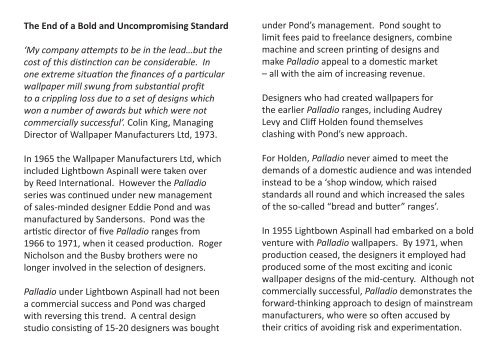You also want an ePaper? Increase the reach of your titles
YUMPU automatically turns print PDFs into web optimized ePapers that Google loves.
The End of a Bold and Uncompromising Standard<br />
‘My company attempts to be in the lead…but the<br />
cost of this distinction can be considerable. In<br />
one extreme situation the finances of a particular<br />
wallpaper mill swung from substantial profit<br />
to a crippling loss due to a set of designs which<br />
won a number of awards but which were not<br />
commercially successful’. Colin King, Managing<br />
Director of Wallpaper Manufacturers Ltd, 1973.<br />
In 1965 the Wallpaper Manufacturers Ltd, which<br />
included Lightbown Aspinall were taken over<br />
by Reed International. However the <strong>Palladio</strong><br />
series was continued under new management<br />
of sales-minded designer Eddie Pond and was<br />
manufactured by Sandersons. Pond was the<br />
artistic director of five <strong>Palladio</strong> ranges from<br />
1966 to 1971, when it ceased production. Roger<br />
Nicholson and the Busby brothers were no<br />
longer involved in the selection of designers.<br />
<strong>Palladio</strong> under Lightbown Aspinall had not been<br />
a commercial success and Pond was charged<br />
with reversing this trend. A central design<br />
studio consisting of 15-20 designers was bought<br />
under Pond’s management. Pond sought to<br />
limit fees paid to freelance designers, combine<br />
machine and screen printing of designs and<br />
make <strong>Palladio</strong> appeal to a domestic market<br />
– all with the aim of increasing revenue.<br />
Designers who had created wallpapers for<br />
the earlier <strong>Palladio</strong> ranges, including Audrey<br />
Levy and Cliff Holden found themselves<br />
clashing with Pond’s new approach.<br />
For Holden, <strong>Palladio</strong> never aimed to meet the<br />
demands of a domestic audience and was intended<br />
instead to be a ‘shop window, which raised<br />
standards all round and which increased the sales<br />
of the so-called “bread and butter” ranges’.<br />
In 1955 Lightbown Aspinall had embarked on a bold<br />
venture with <strong>Palladio</strong> wallpapers. By 1971, when<br />
production ceased, the designers it employed had<br />
produced some of the most exciting and iconic<br />
wallpaper designs of the mid-century. Although not<br />
commercially successful, <strong>Palladio</strong> demonstrates the<br />
forward-thinking approach to design of mainstream<br />
manufacturers, who were so often accused by<br />
their critics of avoiding risk and experimentation.<br />
<strong>Palladio</strong> <strong>catalogue</strong>.indd 22<br />
7/26/2016 7:06:21 PM


